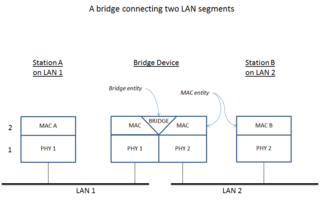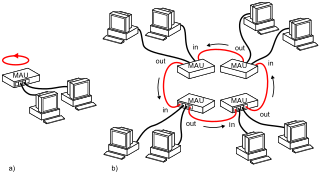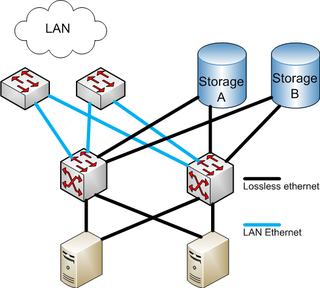This article needs additional citations for verification .(September 2008) |
Local Management Interface (LMI) is a term for some signaling standards used in networks, namely Frame Relay and Carrier Ethernet.
This article needs additional citations for verification .(September 2008) |
Local Management Interface (LMI) is a term for some signaling standards used in networks, namely Frame Relay and Carrier Ethernet.
LMI is a set of signalling standards between routers and Frame Relay switches. Communication takes place between a router and the first Frame Relay switch to which it is connected. Information about keepalives, global addressing, IP multicast and the status of virtual circuits is commonly exchanged using LMI.
There are three standards for LMI:
Ethernet Local Management Interface (E-LMI) is an Ethernet layer operation, administration, and management (OAM) protocol defined by the Metro Ethernet Forum (MEF) for Carrier Ethernet networks. It provides information that enables auto configuration of customer edge (CE) devices.

Asynchronous Transfer Mode (ATM) is a telecommunications standard defined by American National Standards Institute (ANSI) and ITU-T for digital transmission of multiple types of traffic. ATM was developed to meet the needs of the Broadband Integrated Services Digital Network as defined in the late 1980s, and designed to integrate telecommunication networks. It can handle both traditional high-throughput data traffic and real-time, low-latency content such as telephony (voice) and video. ATM provides functionality that uses features of circuit switching and packet switching networks by using asynchronous time-division multiplexing.

Ethernet is a family of wired computer networking technologies commonly used in local area networks (LAN), metropolitan area networks (MAN) and wide area networks (WAN). It was commercially introduced in 1980 and first standardized in 1983 as IEEE 802.3. Ethernet has since been refined to support higher bit rates, a greater number of nodes, and longer link distances, but retains much backward compatibility. Over time, Ethernet has largely replaced competing wired LAN technologies such as Token Ring, FDDI and ARCNET.
Multiprotocol Label Switching (MPLS) is a routing technique in telecommunications networks that directs data from one node to the next based on labels rather than network addresses. Whereas network addresses identify endpoints the labels identify established paths between endpoints. MPLS can encapsulate packets of various network protocols, hence the multiprotocol component of the name. MPLS supports a range of access technologies, including T1/E1, ATM, Frame Relay, and DSL.

Frame Relay is a standardized wide area network (WAN) technology that specifies the physical and data link layers of digital telecommunications channels using a packet switching methodology. Originally designed for transport across Integrated Services Digital Network (ISDN) infrastructure, it may be used today in the context of many other network interfaces.

Synchronous optical networking (SONET) and synchronous digital hierarchy (SDH) are standardized protocols that transfer multiple digital bit streams synchronously over optical fiber using lasers or highly coherent light from light-emitting diodes (LEDs). At low transmission rates data can also be transferred via an electrical interface. The method was developed to replace the plesiochronous digital hierarchy (PDH) system for transporting large amounts of telephone calls and data traffic over the same fiber without the problems of synchronization.
A network switch is networking hardware that connects devices on a computer network by using packet switching to receive and forward data to the destination device.

Data terminal equipment (DTE) is an end instrument that converts user information into signals or reconverts received signals. These can also be called tail circuits. A DTE device communicates with the data circuit-terminating equipment (DCE). The DTE/DCE classification was introduced by IBM.
A virtual local area network (VLAN) is any broadcast domain that is partitioned and isolated in a computer network at the data link layer. In this context, virtual, refers to a physical object recreated and altered by additional logic, within the local area network. VLANs work by applying tags to network frames and handling these tags in networking systems – creating the appearance and functionality of network traffic that is physically on a single network but acts as if it is split between separate networks. In this way, VLANs can keep network applications separate despite being connected to the same physical network, and without requiring multiple sets of cabling and networking devices to be deployed.
A data link connection identifier (DLCI) is a Frame Relay 10-bit-wide link-local virtual circuit identifier used to assign frames to a specific PVC or SVC. Frame Relay networks use DLCIs to statistically multiplex frames. DLCIs are preloaded into each switch and act as road signs to the traveling frames.
Cisco Discovery Protocol (CDP) is a proprietary Data Link Layer protocol developed by Cisco Systems in 1994 by Keith McCloghrie and Dino Farinacci. It is used to share information about other directly connected Cisco equipment, such as the operating system version and IP address. CDP can also be used for On-Demand Routing, which is a method of including routing information in CDP announcements so that dynamic routing protocols do not need to be used in simple networks.

A metropolitan-area Ethernet, Ethernet MAN, or metro Ethernet network is a metropolitan area network (MAN) that is based on Ethernet standards. It is commonly used to connect subscribers to a larger service network or the Internet. Businesses can also use metropolitan-area Ethernet to connect their own offices to each other.

Ethernet flow control is a mechanism for temporarily stopping the transmission of data on Ethernet family computer networks. The goal of this mechanism is to avoid packet loss in the presence of network congestion.

A network bridge is a computer networking device that creates a single, aggregate network from multiple communication networks or network segments. This function is called network bridging. Bridging is distinct from routing. Routing allows multiple networks to communicate independently and yet remain separate, whereas bridging connects two separate networks as if they were a single network. In the OSI model, bridging is performed in the data link layer. If one or more segments of the bridged network are wireless, the device is known as a wireless bridge.
In telecommunications, a network-to-network interface (NNI) is an interface that specifies signaling and management functions between two networks. An NNI circuit can be used for interconnection of signalling, Internet Protocol (IP) or ATM networks.

Token Ring is a computer networking technology used to build local area networks. It was introduced by IBM in 1984, and standardized in 1989 as IEEE 802.5.
40 Gigabit Ethernet (40GbE) and 100 Gigabit Ethernet (100GbE) are groups of computer networking technologies for transmitting Ethernet frames at rates of 40 and 100 gigabits per second (Gbit/s), respectively. These technologies offer significantly higher speeds than 10 Gigabit Ethernet. The technology was first defined by the IEEE 802.3ba-2010 standard and later by the 802.3bg-2011, 802.3bj-2014, 802.3bm-2015, and 802.3cd-2018 standards.
A forwarding information base (FIB), also known as a forwarding table or MAC table, is most commonly used in network bridging, routing, and similar functions to find the proper output network interface controller to which the input interface should forward a packet. It is a dynamic table that maps MAC addresses to ports. It is the essential mechanism that separates network switches from Ethernet hubs. Content-addressable memory (CAM) is typically used to efficiently implement the FIB, thus it is sometimes called a CAM table.

The Cisco 2500 series routers are a series of 19" rack mount access routers typically used to connect Ethernet or Token Ring networks via ISDN or leased serial connections. The routers are based on a Motorola 68EC030 CISC processor. This line of routers is no longer sold or supported by Cisco Systems. They were superseded by the Cisco 2600 series, which has also reached EOL now.

Fibre Channel over Ethernet (FCoE) is a computer network technology that encapsulates Fibre Channel frames over Ethernet networks. This allows Fibre Channel to use 10 Gigabit Ethernet networks while preserving the Fibre Channel protocol. The specification was part of the International Committee for Information Technology Standards T11 FC-BB-5 standard published in 2009.